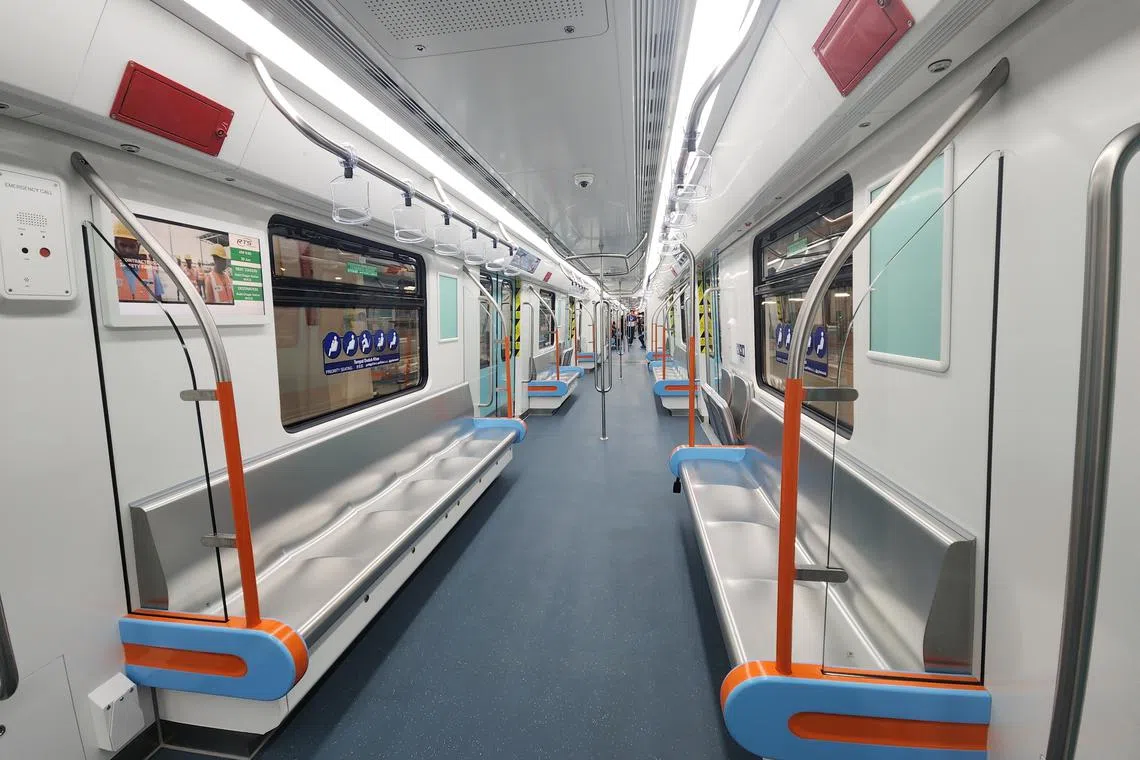First train for JB-Singapore Rapid Transit System unveiled; service to start by December 2026
First China-made train for the cross-border rail system to be tested in Singapore, ahead of preparation for passenger service

[SINGAPORE] The first train for the Johor Bahru (JB)-Singapore Rapid Transit System (RTS) Link was unveiled on Monday (Jun 30), with the cross-border rail system currently estimated to be about 56 per cent complete.
The move is seen to pave the way for a more integrated economic corridor between Singapore and Johor. When fully operational, it is expected to alleviate congestion on the Causeway, one of the busiest land crossings in the world.
The 4-km light rail system will move passengers between Woodlands North station in Singapore and Bukit Chagar station in JB. It is expected to begin passenger service by December 2026.
It will have eight trains manufactured by China Railway Rolling Stock Corporation Zhuzhou Locomotive.
The first train, delivered to Singapore in April, was unveiled in a joint ceremony between Singapore and Malaysia’s transport ministries at the Singapore Rail Test Centre in Tuas.

The transport ministers of both countries said that the unveiling was an important milestone towards full operation of the rail service, as well as a symbol of stronger bilateral ties.
Singapore’s Acting Transport Minister Jeffrey Siow said: “With the unveiling of the first train, we are one step closer to the commencement of RTS Link service.
“The RTS Link will boost connectivity between our two countries. It will foster stronger ties between our peoples, and it will also generate shared economic and social benefits, be it travelling to and from work, exploring the wide range of leisure options on both sides, or staying connected with loved ones.”
Malaysia’s Transport Minister Anthony Loke said: “Today is a very important milestone for this RTS project. In fact, we are in the final 18 months before we see the completion and operation of RTS.
“Let’s be clear – this project is no ordinary infrastructure. It represents strengthening ties of friendship, trust and mutual respect between Malaysia and Singapore, showcasing to the world of increasing trade protectionism what we can achieve when we work together.”
He added that the RTS Link is a “major component of the Johor-Singapore Special Economic Zone”.
“Without this link, I’m sure it would not be as interesting as we are today,” he noted.
Rail link operator RTS Operations (RTSO) will carry out off-site systems integration testing on the first train at Singapore Rail Test Centre over the next few months. This includes integrating the train with the signalling system, platform screen doors and onboard communications system.
RTSO is a joint venture between Singapore transport operator SMRT and Malaysian public transport company Prasarana.
Final assembly of the other seven trains in Malaysia began in the fourth quarter of 2024 and is expected to be completed in Q4 2025.
From Q4 2025 to Q3 2026, testing of the main rail line between Woodlands and Bukit Chagar will take place. Trial operations will begin in Q4 2026, before passenger service starts.
Addressing queries on rail system’s fares, Loke said RTSO is doing its final market study to determine fares.
“We hope that the right price mechanism is in place to ensure that it can encourage more people to use the RTS Link,” he said.
“The whole idea of this project is to make the modal shift to ensure that more people use public transport to cross the Causeway.”
Both ministers also voiced their support for an open payment system with more modes of payment.
“What we mean is we do want to give commuters as many options as possible, so that it’s very convenient for them,” Siow said.
Each RTS Link train is automated, with no driver aboard, and can carry a maximum of 1,087 people across four cars.
The line’s peak capacity is 10,000 passengers per hour, per direction. The journey between the two stations will take around five minutes, with trains running from 6 am to 12 midnight daily.
Passengers will clear both countries’ customs and immigration control at the station of origin, leaving them free to depart when they arrive across the border.
Last year, Loke said that RTS Link will reduce Causeway congestion by 35 per cent, noting that 350,000 people use the land connection between Johor Bahru and Singapore daily.
Decoding Asia newsletter: your guide to navigating Asia in a new global order. Sign up here to get Decoding Asia newsletter. Delivered to your inbox. Free.
Copyright SPH Media. All rights reserved.


